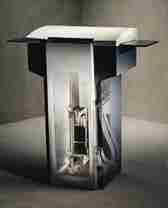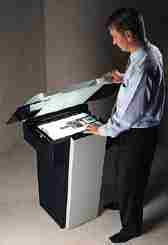May 17, 1996
ScanView targets Topaz with latest scanner
1117 flatbed robotic unit: $39,995

On May 7, ScanView announced an addition to its scanner product line: the 4,000-dpi, large-format flatbed unit called the ScanMate F8. It is designed to deliver professional quality, speed and flexibility in an easy-to-use packagea direct competitor to the Linotype-Hell Topaz and Scitex Smart 340 of the same format and the smaller Agfa SelectScan Plus.
The F8 is a floor-standing unit, like the Topaz, with a new design characteristic of products designed in Denmark. The optical system has been integrated into the floor stand, which reduces the physical dimensions of the scanner.
When we first saw the F8, it reminded us both of an aircraft and a bird. We mentioned this idea to ScanView and were told that the initial plan was to give it a bird's name. In fact, several birds' names were considered before F8 was selected -- the name of an aircraft.
Technology:
- Ccd array. The F8 uses an 8,640-element trilinear ccd array, which means that the red, green and blue filters are integrated directly into the ccd sensors and that the scanner scans the original in one pass. Organic gel filters are mounted directly on the ccd element, to avoid using moving parts, as would occur with a rotating filter wheel.
- Light source. The F8 uses a fluorescent light source instead of a halogen or other light to save on the costs of construction and maintenance and to benefit from the greater continuous range of luminance it provides, ScanView says. The fluorescent lamps are custom designed to give the best possible coverage of the red, green and blue wavelengths for transmissive scanning, as well as the remainder of the visible spectrum for reflective scanning.
- Zoom lens. A zoom lens system is mounted vertically, rather than horizontally, which avoids using mirrors and, ScanView claims, reduces the susceptibility of the optical system to dust. We suspect it also results in a scanner that is easier to support. As an aside, the zoom system is manufactured to ScanView's specification by a company belonging to the Agfa group (not the prepress portion).
- Descreening. For scanning printed material or prescreened film, the F8 provides a descreening function that takes the optical system slightly out of focus. This is a common feature for scanners of this type, and not as sophisticated as the algorithm-based approach used by Eskofot in its Eskoscan scanners and CopyDot software.
Specifications:
- Scanning area. The maximum scanning area is 11x17 for reflective originals and 8x17 for transparencies. The scanner offers both preview and batch scanning modes.
- Speed. At maximum resolution, it scans 300,000 pixels per second (18 megabits per minute), which makes it possible to digitize between 20 and 27 slides (35mm) per hour.
- Resolution. The maximum optical resolution of 4,000 dpi is attained when scanning a maximum area of 2.16 x2.16 inches. For larger areas, the resolution is reduced, such as 2,150 dpi for a 4x5 original and 700 dpi when scanning the entire bed. These figures reflect true optical resolution. When ScanView's ColorQuartet software is used, it is possible to interpolate the resolution to achieve 4,000 dpi over the entire bed.
- Density and bit depth. The F8 has an optical density range of 3.6 and a Dmax of 3.8. When the new ColorTrio scanning software is used, images are captured at a depth of 14 bits per color channel (16,384 gray levels per color). With ColorQuartet, the depth is 16 bits per color (65,536 gray levels per color). We should emphasize, though, that looking only at the number of bits per color channel can be misleading. The signal-to-noise ratio, which defines how accurately the image and colors are reproduced, is as important.
 Target markets
Target markets
The ScanMate F8 is targeted at professional users that need to scan a variety
of originals, including bound and oversized items as well as all types of
transparencies, negatives and reflective images -- in other words, the traditional
graphic arts industry, such as service bureaus, commercial printers and
repro houses. But a key component of that market is an emerging segment that is moving toward high-quality scanning. It includes newspapers, publishing companies, corporate publishing departments and ad agencies, many of which are more familiar with flatbed scanning than drum scanning. The lower investment level for a flatbed device is a key factor here.
In addition, in the established graphic arts industry in general, there is an increasing interest in obtaining a flatbed scanner to supplement an existing drum scanner.
Price and availability
The ScanMate F8 scanner is priced at $39,995 (220,000 Danish kroner), available on May 22. No pricing or delivery date has been set for the EasyMount external mounting table.Prospects
It is always difficult to predict the success of a new product, but sometimes there are indications that guide our projections. In the case of the ScanMate F8, the signs augur well for the future.The company doesn't have to establish its own reputation while it proves the viability of the scanner. It is a well-known supplier of professional desktop scanners. Its drum scanners have sold well in almost every market that ScanView has entered.
The flatbed market is new for ScanView, but it is known to be a good market, based on the success of Linotype-Hell and Scitex.
As evidence of the faith that ScanView has in this new scanner, it plans to produce 100 units per month -- nearly, we believe, the shipping rate for Topaz units in its early months.
© Copyright 1997 Seybold Seminars; Last modified 4/10/97 at 12:29:04 PM.
